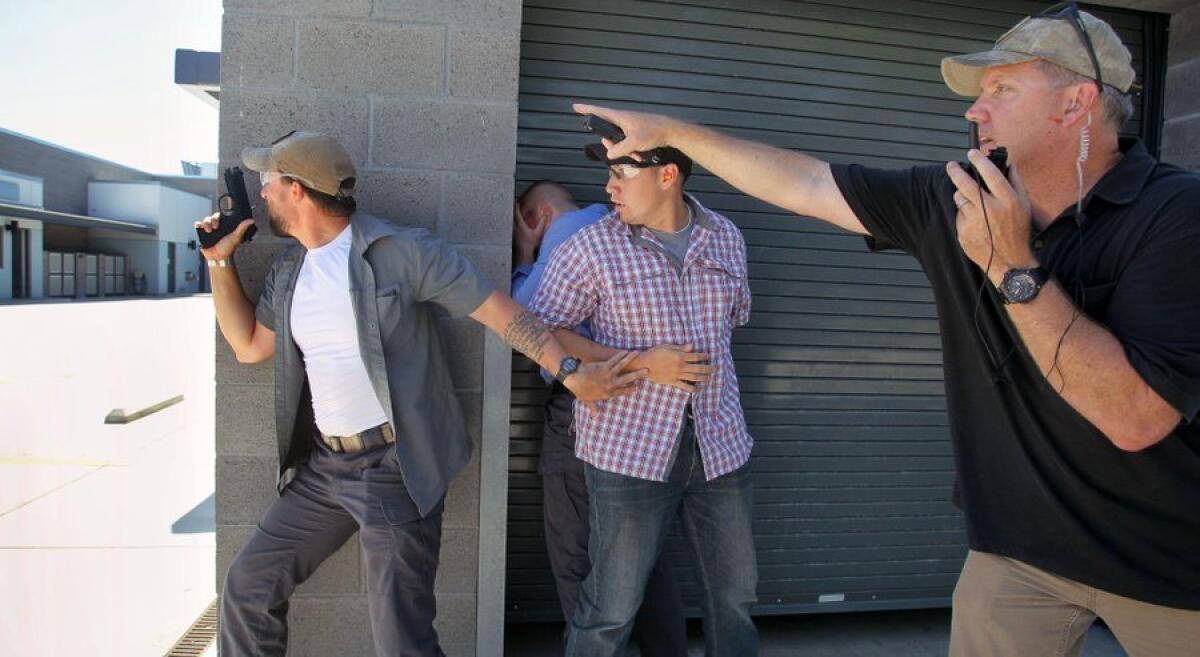Fighting off would-be kidnappers while dodging snipers: It’s all part of training to be a high-security specialist

- Share via
Reporting from Carlsbad, Calif. — There are some things you just can’t experience in a classroom. But you can learn them in a simulated firefight with insurgents trying to kidnap someone under your protection.
“Let me give you some advice,” Rick Sweeney told students taking his high-threat security class. “Don’t go to a white SUV. They’re all booby-trapped. If you go to a white one, you will die. You’ll kill your client.”
Moments later, a loud bang and a high-pitched whistle cut through the air.
“Guys, guys, we got mortars coming in,” Sweeney yelled.
The next several minutes were a flurry of loud blank gunshots, victims covered in fake blood and booming explosions as the students tried to save their client.
The simulated attack at the Carlsbad Safety Training Center was one of the last assignments for students in the high-threat protection course offered through MiraCosta College’s Community Education Department.
Students come from across the country to earn a High Threat Protection Specialist certificate, which can lead to lucrative but dangerous careers.
The program — one of only three of its kind in the country, according to a schools administrator — readies students for some of the most dangerous scenarios imaginable. Some graduates work overseas to protect State Department officials, nonprofit workers and business people under threats from terrorists and kidnappers.
“One of our students who went over as a medic for the State Department is making $680 a day,” Sweeney said. “The average is $120,000 a year.”
Most of the students did not study beyond high school, and about 85% are former military members using the G.I. Bill to cover the $11,975 cost of the course — which consists of a six-day trauma medical program, an eight-day section on protection of celebrities and corporate executives, and the 19-day high-threat protection segment.
Many of the lessons are taught at MiraCosta College’s Technology Career Institute. The course also includes some road trips, including a visit to Los Angeles, where students work with actors playing high-profile celebrities who are picked up from an airport and taken to restaurants or actual red-carpet events.
That trip is to learn the logistics of tracking flights and navigating the city where students are most likely to work if hired for celebrity security.
To prepare for kidnappers, terrorists and other severe threats, the class uses the four-acre Carlsbad Safety Training Center.
The session began with Sweeney dropping off two students outside a brick building and telling them to extract a client. They found themselves under a mortar attack even before they reached the client, who was frantic and wounded.
Following instructions from an off-site command center, the students escorted the client across a courtyard, passing an exploding SUV while under fire from a sniper. They found brief shelter in a room where another man was severely bleeding from a leg wound, but then were instructed to make their way to another building.
After exchanging gunfire with another sniper, the men entered the building to find enemies and innocents — learning the difference is part of their training — while making their way up several flights in hopes of finding a helicopter to take them to safety.
That plan was aborted, and they made their way to another building while engaging in yet another firefight.
In their final test, the students were placed in a dark room and told to escape plastic and metal handcuffs. They said afterward that their classroom training left them well-prepared for the simulated scenario.
“It felt natural,” said Ryan Jarvis, who came from Virginia to take the course. “When you’re put in a hostile, stressful environment, sometimes things just come together for you.
Jarvis has served in the Navy for 12 years, including seven in military law enforcement. As he prepares to leave the service, he said, he found overseas security appealing because of the people with whom he would work.
“It’s the kind of community I want to be involved with,” he said. “The people you work in those types of environments, they have your back.”
Warth writes for the San Diego Union-Tribune.
More to Read
Sign up for Essential California
The most important California stories and recommendations in your inbox every morning.
You may occasionally receive promotional content from the Los Angeles Times.













